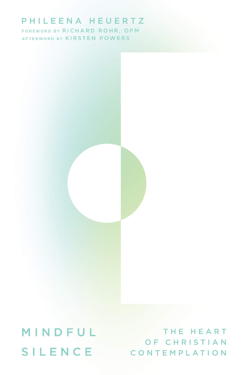
As has become a July tradition at The Well, we have the opportunity to share excerpts of a book we enjoyed this year.
We settled on Mindful Silence: The Heart of Christian Contemplation by Phileena Heuertz because of its invitation to spiritual growth through the practice of contemplative prayer. Her own experience with this practice came after years of Christian work in developing countries, and an inability to reconcile what she witnessed in the world with “what I had learned about God growing up in the Protestant pews of Indiana.” Contemplative prayer became a new way of relationship with God.
While the work to which you are called might not look like hers, might you resonate with the sense of weight of responsibility, important problems which you are not able to fully solve on your own, and a general exhaustion? This invitation to contemplative prayer offers a way forward when you’re not sure what to make of your faith anymore.
We hope the introduction to Mindful Silence is meaningful for you too. Come back each Thursday in July for another glimpse into this book!
— Andrea Bridges
Practice: Centering Prayer
by Phileena Heuertz, excerpted from Mindful Silence: The Heart of Christian Contemplation
 Centering prayer roots us in divine love. It is a modernized prayer method based on the intuitive prayer rooted in lectio divina and The Cloud of Unknowing. It is a method of silent prayer that prepares us to receive the gift of contemplative prayer — prayer in which we experience the divine’s immanent presence with us. Centering prayer is grounded in relationship with God, through Christ, and is a practice to nurture that relationship.
Centering prayer roots us in divine love. It is a modernized prayer method based on the intuitive prayer rooted in lectio divina and The Cloud of Unknowing. It is a method of silent prayer that prepares us to receive the gift of contemplative prayer — prayer in which we experience the divine’s immanent presence with us. Centering prayer is grounded in relationship with God, through Christ, and is a practice to nurture that relationship.
Unlike other prayer practices, in centering prayer we are not looking for an insight, impression, takeaway, or any other experience. This is a nonconceptual prayer practice and therefore very different from most other forms of prayer we’ve experienced. It is a Christian form of meditation, a practice in letting go of thoughts, feelings, and sensations.
Centering prayer complements and supports other modes of prayer — verbal, mental, or affective prayer. It facilitates resting in the divine presence. Centering prayer offers a way to grow in intimacy with God, moving beyond conversation to communion.
As Father Thomas emphasizes, the source of centering prayer, as in all methods leading to contemplative prayer, is the indwelling Trinity: Father, Son, and Holy Spirit. The focus of centering prayer is the deepening of our relationship with the living Christ. The effects of centering prayer are ecclesial, as the prayer tends to build communities of faith and bond the members together in mutual friendship and love. To practice centering prayer, follow these steps.
- Sit in an upright, attentive posture in a way that allows for a straight spine and open heart. Place your hands in your lap.
- Gently close your eyes and bring to mind your sacred word, image, or breath as your symbol to consent to the presence and action of God within you. Your sacred symbol is intended to be the same every time you pray. It helps to ground you in the present moment. It allows you to give your undivided, loving, yielded attention to God. Choose a name for God or an attribute of God like love, peace, and so on. You may prefer a sacred image instead or simply a mindful breath.
- Silently, with eyes closed, recall your sacred symbol to begin your prayer. As you notice your thoughts, gently return to your sacred symbol. Do this however many times you notice thoughts, feelings, or sensations.
- When your prayer period is over, transition slowly from your practice to your active life.
It is recommended to pray in this fashion for a minimum of twenty minutes, two times a day. Start out slowly with initial prayer periods of five to ten minutes, then work up to the desired length of time.
During a visit with Father Thomas, he commented that two thirty-minute sits is a good start, implying that if we can manage to come up with more time each day, then all the better. Do what works for you. Start with a time limit that is manageable and attainable, and grow your practice from there by the leading of the Holy Spirit.
For more information visit Gravity: A Center for Contemplative Activism.
*Taken from Mindful Silence by Phileena Heuertz. Copyright (c) 2018 by Phileena Heuertz. Published by InterVarsity Press, Downers Grove, IL. www.ivpress.com
If you enjoyed this excerpt, consider purchasing Phileena's book using the 40% off discount code (including free US shipping) that InterVarsity Press is offering readers of The Well: WELL4649
. (Good through September 30, 2019 on the title Mindful Silence.)